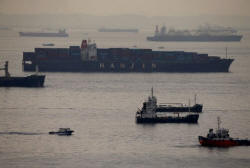|
Doubts raised on Hanjin
rehab plan as ships clog Busan port
 Send a link to a friend
Send a link to a friend
 [September 21, 2016]
By Joyce Lee [September 21, 2016]
By Joyce Lee
SEOUL (Reuters) - The South Korean
court handling Hanjin Shipping's receivership cast doubt on the
container carrier's ability to survive a restructuring, news reports
said, as 13 Hanjin ships crowded waters outside the country's
biggest port.
A rehabilitation plan for the world's seventh-largest container
carrier is "realistically impossible" if top priority debt such as
backlogged charter fees exceed 1 trillion won ($896 million), the
Seoul Central District Court said, South Korea's Yonhap newswire
reported on Wednesday.
Hanjin, which filed for court receivership late last month, must
submit a rehabilitation plan in December that creditors owed
billions of dollars will be called to agree to.
Hanjin has begun returning chartered vessels to their owners and is
trying to secure funds to help unload ships. An estimated $14
billion in cargo was initially trapped on its ships around the
world, creating havoc ahead of the crucial holiday shopping season.
Some 13 Hanjin container ships were waiting in international waters
outside Busan port, according to latest Hanjin data on Wednesday, as
South Korea's largest port struggled to accommodate vessels denied
entry elsewhere and forced to sail home to South Korea.

"It's a highly abnormal situation. Time is money for a shipper, so
the more ships wait, the more losses," a Busan Port Authority
spokeswoman said.
"Some ships are waiting because they cannot leave for their
destination," she said.
At the Hanjin Newport section of Busan port, 78.6 percent of
container capacity was filled as of Wednesday morning, higher than
the 60 percent preferred for efficient operation, the port
spokeswoman said. Of about 33,000 containers at Hanjin Newport,
about 40 percent held cargo.
Busan is one of a handful of major global ports where Hanjin ships
can freely unload cargo without threat from creditors. South Korea's
maritime ministry said earlier this month Busan and Incheon port
authorities will guarantee payments for most services offered to
Hanjin Shipping vessels.
Hanjin was granted stay orders to protect its ships from seizure in
South Korea, the United States, Japan, Britain and provisionally
Singapore earlier this month and is applying for stay orders
elsewhere. However, dozens of ships remained anchored off ports
while Hanjin tries to secure funds to unload cargo.
SHRINKING FLEET
With debt of about 6 trillion won ($5.4 billion) at the end of June
and the South Korean government's unwillingness to mount a rescue,
expectations are low that Hanjin Shipping will survive.

[to top of second column] |

Container vessel Hanjin Rome sits in the eastern anchorage area in
Singapore September 9, 2016. REUTERS/Edgar Su/File Photo

Top priority debt means claims for public interests, which are paid
first to creditors and include cargo owners' damages and unpaid
charter fees, Yonhap reported citing the Seoul Central District
Court.
Backlogged charter fees that occurred after Hanjin Shipping's court receivership
have topped 40 billion won, while cargo owners' claims for damages are expected
to begin in earnest after 3-4 weeks have passed from original delivery
schedules, the report said.
Court officials were not immediately available for comment.
Shares in Hanjin plunged more than 20 percent to a record low after the court
comments were reported, which lent support to the view the company will slide
into liquidation.
Rival Korean shipping company Hyundai Merchant Marine Co Ltd (HMM) surged 16
percent to a near two-week high.
On Wednesday, HMM said it would add a vessel on the Busan to Europe route
starting Sept. 29 to ease the capacity squeeze caused by Hanjin's collapse.
"HMM is the only national shipping company that is left to take care of what
Hanjin Shipping was in charge of for now," said Cho Byung-hyun, an analyst at
Yuanta Securities Korea.
"The market is expecting HMM to take back Hanjin's pie from the industry though
there is still some possibility that shipping companies from China, Taiwan, or
Hong Kong would come in."
($1 = 1,112.7000 won)
(Additional reporting by Dahee Kim; Editing by Lincoln Feast and Tony Munroe)
[© 2016 Thomson Reuters. All rights
reserved.] Copyright 2016 Reuters. All rights reserved. This material may not be published,
broadcast, rewritten or redistributed.
 |